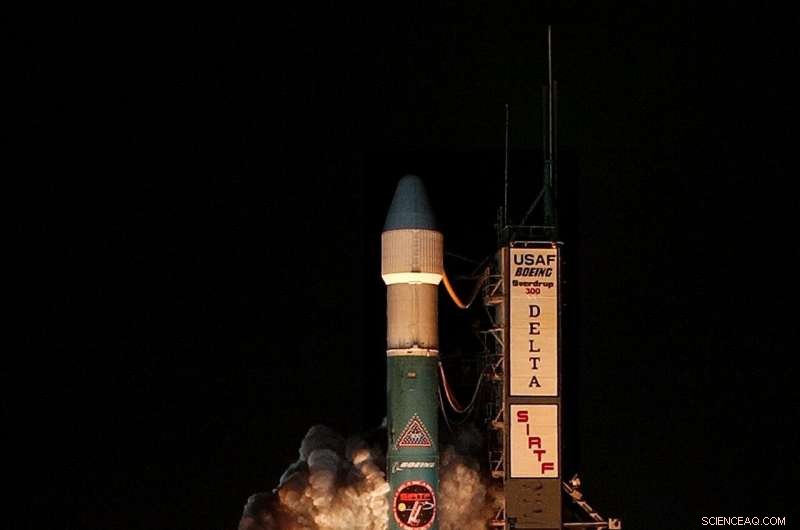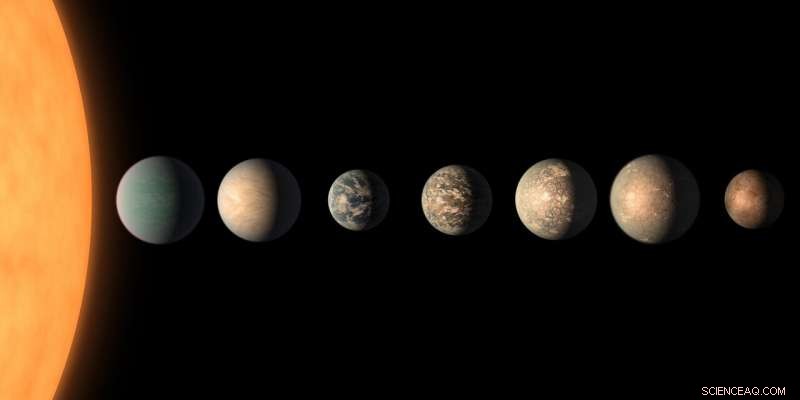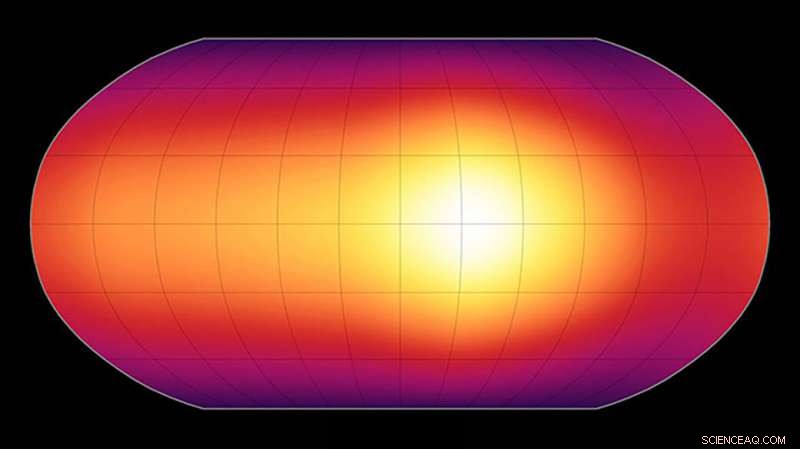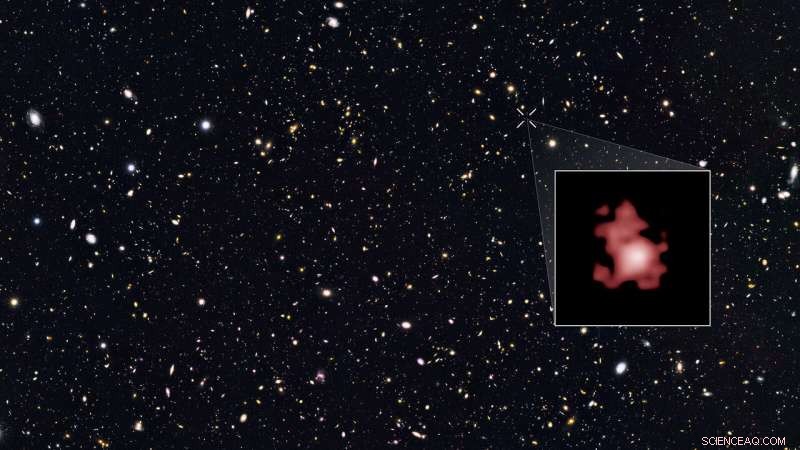
Telescopio espacial Spitzer de la NASA, entonces conocida como la Instalación del Telescopio Infrarrojo Espacial, se lanza desde la Estación de la Fuerza Aérea de Cabo Cañaveral en Florida el lunes, 25 de agosto 2003. Crédito:NASA
Cuando se cierra una ventana al universo, otro se abrirá con una vista aún mejor. Algunos de los mismos planetas las estrellas y galaxias que vimos por primera vez a través de la primera ventana aparecerán con un detalle aún más nítido en la que pronto se abrirá.
El telescopio espacial Spitzer de la NASA concluye su misión el 30 de enero 2020, después de más de 16 extraordinarios años de exploración. El telescopio ha hecho muchos descubrimientos más allá de la imaginación de sus diseñadores, como planetas fuera de nuestro sistema solar, llamados exoplanetas, y galaxias que se formaron cerca del comienzo del universo. Muchos de los avances de Spitzer se estudiarán con más precisión con el próximo telescopio espacial James Webb, que se espera que se lance en 2021.
"Tenemos muchas preguntas nuevas sobre el universo debido a Spitzer, "dijo Michael Werner, Científico del proyecto Spitzer con base en el Laboratorio de Propulsión a Chorro de la NASA en Pasadena, California. "Es muy gratificante saber que hay un conjunto tan poderoso de capacidades que van a dar seguimiento a lo que pudimos comenzar con Spitzer".
Tanto Webb como Spitzer están especializados en luz infrarroja, que es invisible a los ojos humanos. Pero con su gigantesco espejo de berilio bañado en oro y nueve nuevas tecnologías, Webb tiene aproximadamente 1, 000 veces más potente. El próximo telescopio podrá llevar los descubrimientos científicos de Spitzer a nuevas fronteras, desde la identificación de sustancias químicas en atmósferas de exoplanetas hasta la localización de algunas de las primeras galaxias que se formaron después del Big Bang.
Más allá de sus descubrimientos, Spitzer también es un pionero para Webb en términos de cómo operar un telescopio de este tipo. Para medir la luz infrarroja con alta sensibilidad, un telescopio debe estar muy frío. Spitzer ha mostrado a los ingenieros cómo se comporta un observatorio infrarrojo en la inmensidad del espacio y qué temperaturas deben esperar los planificadores de la misión para lidiar con Webb.
"Tener un telescopio enorme en el espacio es difícil. Pero tener un telescopio enorme que está frío es mucho más difícil, "dijo Amber Straughn, científico adjunto del proyecto de Comunicaciones Científicas del Telescopio Espacial James Webb. "Spitzer nos ayudó a aprender cómo operar mejor un telescopio muy frío en el espacio".
Con más de 8, 700 artículos científicos publicados basados en los descubrimientos de Spitzer, el telescopio ha sido una gran ventaja para los astrónomos en una variedad de disciplinas. Muchos de estos resultados tentadores están listos para ser revisados con un telescopio más poderoso, y Webb está preparado para comenzar a investigarlos al principio de su misión. Aquí hay una muestra de los logros de Spitzer sobre los que se basará Webb.

El concepto de este artista muestra cómo puede ser el sistema planetario TRAPPIST-1, basado en los datos disponibles sobre los diámetros de los planetas, masas y distancias de la estrella anfitriona. El telescopio espacial Spitzer confirmó la presencia de dos planetas del tamaño de la Tierra en el sistema antes de descubrir otros cinco. Crédito:NASA / JPL-Caltech
Exoplanetas
Uno de los descubrimientos más impresionantes de Spitzer fue que no hay solo tres, pero siete planetas rocosos del tamaño de la Tierra que orbitan un pequeño, estrella tenue llamada TRAPPIST-1. TRAPPIST-1 es uno de los sistemas planetarios mejor estudiados además del nuestro, pero hay mucho más que aprender al respecto.
El cuarto planeta de la estrella, TRAPPIST-1e es especialmente interesante porque tiene una densidad y gravedad superficial muy similar a la de la Tierra y recibe suficiente radiación estelar para tener temperaturas lo suficientemente amigables para el agua líquida. Webb observará este planeta para tener una mejor idea de si el planeta tiene atmósfera y, si es así, cuál es su química.
La presencia de moléculas como el dióxido de carbono, dominante en Marte y Venus, tendría implicaciones sobre si un planeta podría tener agua líquida y otras condiciones habitables. Webb podrá detectar agua atmosférica, también. Adicionalmente, Webb buscará calor proveniente de TRAPPIST-1b, el planeta más cercano a su estrella.
"La diversidad de atmósferas alrededor de los mundos terrestres probablemente está más allá de nuestra imaginación más salvaje, "dijo Nikole Lewis, profesor asistente de astronomía en la Universidad de Cornell en Ithaca, Nueva York. "Obtener cualquier información sobre el aire en estos planetas será muy útil".
WASP-18b es otro planeta intrigante que Spitzer examinó y que Webb investigará más a fondo en las observaciones al principio de la misión. Este gigante gaseoso con 10 veces la masa de Júpiter, se encuentra muy cerca de su estrella, completando una órbita una vez cada 23 horas. Debido a su alta temperatura, la friolera de 4, 800 grados Fahrenheit (2, 650 grados Celsius) y de gran tamaño, se lo conoce como un "Júpiter caliente". Usando datos de Spitzer y Hubble, Los astrónomos descubrieron en 2017 que este planeta tiene mucho monóxido de carbono en su atmósfera superior y poco vapor de agua. This planet is particularly interesting because it's so close to its star that it's in danger of being torn apart completely, and it may not survive another million years. Astronomers are interested in using Webb to look at the processes happening in this planet's atmosphere, which will provide insights into hot Jupiters in general.
Spitzer has also delivered unprecedented weather reports for exoplanets. En 2007, it made the first-ever map of the surface of an exoplanet, the hot Jupiter HD 189733b, showing its temperature variations and cloud tops. Más recientemente, en 2016, Spitzer highlighted the climate patterns of 55 Cancri e, a possibly lava-covered world more than twice the size of Earth. But maps from Spitzer have given scientists a lot to think about as they look to further investigations with Webb.

This is the first-ever map of the surface of an exoplanet, or a planet beyond our solar system. The map, which shows temperature variations across the cloudy tops of a gas giant called HD 189733b, is made from infrared data taken by NASA's Spitzer Space Telescope. Credit:NASA/JPL-Caltech/Harvard-Smithsonian CfA
Other Exotic Objects
Spitzer has also made strides in identifying and characterizing brown dwarfs. A brown dwarf is larger than a planet but less massive than a star, and while stars generate their own energy by fusing hydrogen, brown dwarfs do not. Spitzer has been able to look at the clouds in brown dwarf atmospheres and observe how they move and change shape with time. Webb will also examine brown dwarf cloud properties and delve deeper into the physics of these mysterious objects.
Infrared light has also been revolutionary for looking at disks of gas and dust orbiting stars, and both Spitzer and Webb are sensitive to the infrared glow of this material. Disks that Spitzer has studied contain the raw materials for making planets and may represent the state of our solar system before Earth and its neighbors formed. Spitzer has seen particles around young stars beginning to transform into the seeds of small planetary bodies, and that some disks have materials similar to those seen in comets in our solar system. Webb can look at the same disks and find out even more about the planetary formation process.
Oodles of Galaxies
As light travels from distant objects to Earth, its wavelength becomes longer because the universe is expanding and those objects are moving farther from us. Just like the sound of a siren seems to lower in pitch as an ambulance drives away, light from distant galaxies also lowers in frequency, a phenomenon called "redshift." That means stars that give off visible light in the early universe will appear in the infrared by the time their light reaches Earth. This makes infrared light an especially powerful tool for exploring the universe's ancient past.
Pinpointing hundreds of billions of galaxies is currently impossible, but Spitzer has made large galaxy catalogs that represent different slices of the universe, containing some of the most distant galaxies we know. The large survey areas of Spitzer and Hubble Space Telescope have allowed astronomers to efficiently look for objects that could be studied in further detail with Webb.
Por ejemplo, Spitzer, together with Hubble, took an image of a galaxy called GN-z11, which holds the record for most distant galaxy measured yet. It is a relic from when the universe was only 400 million years old, just 3% of its current age and less than 10% of its size today.

This is the first-ever map of the surface of an exoplanet, or a planet beyond our solar system. The map, which shows temperature variations across the cloudy tops of a gas giant called HD 189733b, is made from infrared data taken by NASA's Spitzer Space Telescope. Credit:NASA/JPL-Caltech/Harvard-Smithsonian CfA
"Spitzer surveyed thousands of galaxies, mapped the Milky Way and performed other groundbreaking feats by looking at large areas of the sky, " said Sean Carey, manager of the Spitzer Science Center at Caltech/IPAC in Pasadena, California. "Webb won't have this capability, but it will revisit some of the most interesting targets in the Spitzer surveys to reveal them in amazing clarity."
Y lo que es más, Webb's higher sensitivity will allow the telescope to look for galaxies dating back even earlier in the universe. And questions still abound about these distant galaxies:Are there a lot of stars forming in them or relatively few? Are they rich in gas or poor? Are there black holes at their centers, and how do those black holes interact with stars? Y, scientists have pondered a chicken-and-egg problem for decades about which came first:the black hole or the surrounding galaxy?
"We'll be able to see some of the earliest galaxies to form in the universe that we've never seen before, " said Straughn.
Mas cerca de casa, Spitzer also studied many examples of a mysterious kind of galaxy called a luminous infrared galaxy, or LIRG. Such galaxies are generating tens to hundreds of times more energy per second than a typical galaxy, and most of that energy takes the form of far-infrared light. Scientists have used Spitzer to study LIRGs and learn about star formation and the growth of black holes during periods of rapid evolution when galaxies collide and merge. Such collisions were even more common 6 billion to 10 billion years ago and influenced the evolution of the universe as we know it.
"Webb will take inspiration from Spitzer and examine a variety of nearby and distant LIRGs to learn more about the role of galactic mergers, bursts of star formation and the growth of supermassive black holes in galactic evolution over cosmic time, " said Lee Armus of Caltech, who will lead a LIRG observing program for Webb.
Into the Infrared Unknown
For more than 16 years, Spitzer mapped out many of the most pressing questions in infrared astronomy. Now it's up to Webb to revisit them with sharper vision, through the grandest window yet to the cosmos.